Time to read: 14 min
This article was originally published in February, 2017 by Jeremy Hill. The content has been updated.
Geometric Dimensioning and Tolerancing (GD&T or GD and T) is a standardized system engineers and manufacturers use to define and communicate design intent, product geometry, and tolerances to ensure precise control over manufacturing variations. The US military created a proto-GD&T in the 1940s with the MIL-STD-8 publication (NOTE: MIL-STD-8 has since been canceled). GD&T has evolved since then and is now commonly used across the industry. ASME Y14.5 (latest revision is 2018) is now considered the standard guideline for GD&T.
Index
This article is a convenient guide for Geometric Dimensioning and Tolerancing (GD&T) and includes:
- CNC Machining Tolerances
- Datums and Features
- Basic Dimensions
- GD&T Symbols
- Material Condition Modifiers
- Feature Control Frames
GD&T Overview
GD&T is a way of describing the dimensions and tolerances that’s different from traditional coordinate measurement plus/minus tolerancing. Fundamentally, engineers design a part with perfect geometry in CAD, but manufactured parts are never perfect. Proper use of GD&T can improve quality and reduce the time and cost of delivery. It accomplishes this by providing a common language to accurately express design intent and focusing on functional interfaces to tolerance a part.
These are the main benefits of using Geometric Dimensioning and Tolerancing (GD&T):
- Standardized design language
- Clear, precise, and consistent communication between customers, suppliers, and production teams
- Method for calculating the worst-case mating limits
- Repeatable production and inspection processes
- Assembly is assured from qualified production parts
By deepening your knowledge of GD&T, you improve communication with your manufacturing and quality control teams, ensuring alignment on top-quality manufactured parts. Fictiv’s global network of highly-vetted manufacturing partners, coupled with our extensive capabilities, further enhances these benefits. Our AI-powered technology platform ensures faster, smarter decisions, while our dedicated team guarantees the highest standards of service and quality, aligning with the precision and efficiency that GD&T brings to custom manufacturing.
There is a lot to learn when it comes to mastering GD&T, so this post will serve as a starting point to help you understand the most important GD&T basics and concepts, including:
- CNC machining tolerances
- The Datum Reference Frame
- Basic Dimensions
- Interpreting GD&T Symbols
- Applying Geometric Symbols to Engineering Drawings
- Material Condition Modifiers
- The Feature Control Frame
The alternative to GD&T is the coordinate measurement square tolerancing approach or ‘conventional tolerancing. Square tolerancing uses square tolerance zones formed as a rectangular box around a coordinate, while GD&T uses circular/cylindrical tolerance zones formed around a point — which results in a tolerance zone that is 57% larger with GD&T. Also, coordinate measurement systems do not clearly define inspection requirements or design intent, but GD&T defines both in a clear and concise manner.
If you want to learn more about this topic, check out our on-demand webinar on Conveying Design Intent with GD&T.
Tolerances
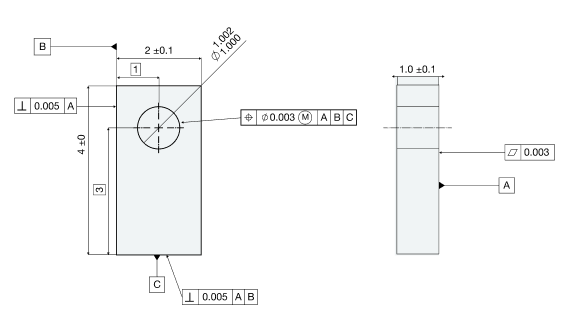
Tolerances are the ‘T’ in GD&T and are the allowable amount of variation for a physical dimension. It’s important to keep tolerances on engineering drawings in perspective — tolerances for a given part may not be visible to the naked eye, but they can have a large impact on the performance of the part or assembly.
When you look at CNC machined parts, they look flat and straight, but if you were to precisely measure every single cross-section of the part, you would find many imperfections. These variations or imperfections are allowed within the tolerance limits placed on the parts — the limits were selected with the understanding that all parts will have varying degrees of imperfection.
As a general rule, an engineer or designer should strive to keep tolerances as large as possible while still maintaining the function of the part. Small or tight tolerances can increase costs in the manufacturing, inspection, and tooling for manufacturing parts. Tight tolerances are sometimes necessary, but it’s best to make them as loose as you can to save on those costs.
To provide some context around tolerances, let’s consider an average human hair, which is around .005 inches in diameter. In general, tolerances of +/- .005 inch are expected and achieved from today’s CNC mills. However, just because you can hold tolerances smaller than human hair doesn’t mean you need to (or that you should). Follow our guidelines for specifying CNC machining tolerances.
Pro-Tip: To learn how to conduct a tolerance analysis, read our post on the topic.
Datums and Features
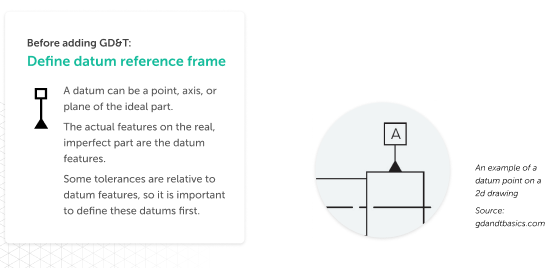
In design engineering, the Datum Reference Frame (DRF) is a three-dimensional Cartesian coordinate system against which the part’s tolerances, tolerance symbols, and geometric features are defined. It’s arguably the most important concept in GD&T and has a significant impact on the manufacturability and inspectability of a part. The DRF is the skeleton of the geometric system — it’s the frame of reference to which all referenced geometric specifications are related and the origin of all dimensions and geometric specifications related to it. A datum reference frame should mimic the assembly of the part.
A DRF establishes Six Degrees of Freedom (DOF) with three translational and three rotational. In order to design, manufacture, and verify parts, the necessary DOF must be constrained. Parts are mated to the DRF so measurements, processing, and calculations can be made.
There’s an important distinction between datums and datum features. Datums are points, axes (lines), and planes, or some combination of these components, that make up the DRF. Datum features are the actual physical features (holes, faces, slots, etc.) on the part. They’re not perfect — they have variation. The illustrations below are provided to emphasize that Datums (left) are theoretical (perfect) and datum features (right) are real (imperfect).

In defining a part, an engineer will identify the datum features on a part that are most important to the functional requirements of the design — usually, the features that interface with other components in an assembly. Datum features referenced in a feature control frame (see Feature Control Frame) will, in order of precedence, orient the part to the datum reference frame.
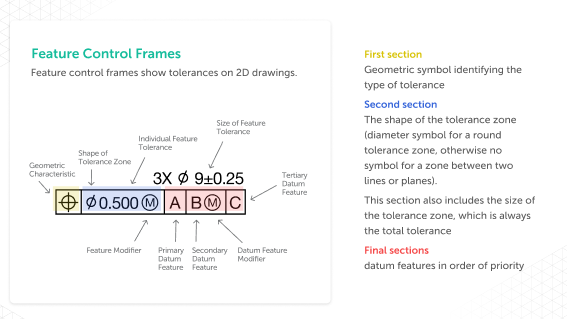
A Feature of Size refers to any geometric shape defined by dimensions like an angle, length, or height, and a Feature of Size can be defined as a datum (think a hole or post). You can use the caliper rule when determining if something can be characterized as a Feature of Size or not. If you can put the tips of a caliper around or inside of the part and they both touch the surfaces of the part, then the feature is a Feature of Size.
If you have to use the probe end of the calipers to measure a feature, it’s not a feature of size. Tolerances can also be applied to features of size, and when orientation tolerances are applied to features of size, they control the angle of the axis/midplane within the tolerance zone at a basic angle to a datum.
GD&T Basic Dimensions
Basic dimensions are theoretically exact numerical values used to define the form, size, orientation, or location of a part or feature. Basic dimensions are usually shown on a drawing enclosed in a box, but they can also be invoked by referencing a standard or by a note on the drawing. The CAD model itself can also be defined as basic.
Permissible variations from basic dimensions are usually defined in the GD&T feature control frame or by notes on the drawing. Any default tolerances in the title block of a drawing do not apply to basic dimensions. Often, basic dimensions are not utilized for quality inspection purposes. Basic dimensions are measured, but since they don’t typically have a tolerance associated with them, they are not typically used for pass/fail criteria.
GD&T Symbols
GD&T is a feature-based system where all engineered parts are composed of features. Geometric tolerances are applied to features with feature control frames, which utilize a series of symbols to describe the tolerance allowed. These Symbols or Geometric Characteristics are what most often come to mind when people think about GD&T. There are numerous GD&T characteristics, and some of the most commonly used symbols that represent them are shown in the symbol “cheat sheet” below.
These characteristics and their symbols fall into four main categories (or characteristics of features): form, orientation, location, and runout.
- Form tolerances control the “shape” of features and are often used as a refinement of size, which means they do not require a datum reference.
- Orientation tolerances control the “tilt” of features, are always associated with basic angle dimensions, and are often used as a refinement to location. Due to the relative nature of orientation GD&T, these feature control frames will always include a reference to a datum. If applied to surfaces, orientation tolerances will control form.
- Location tolerances control the location and are always associated with basic linear dimensions. Location GD&T may locate a feature or feature of size based on the feature itself or a series of derived median points. These characteristics can be incredibly versatile and powerful, potentially controlling size, form, and orientation within a single feature control frame.
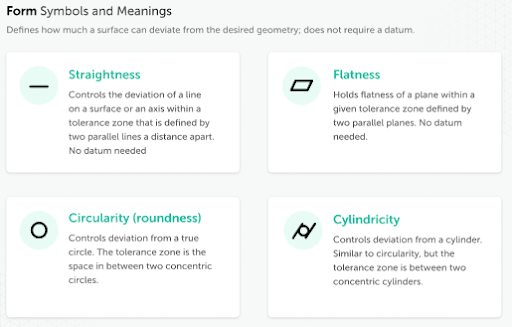
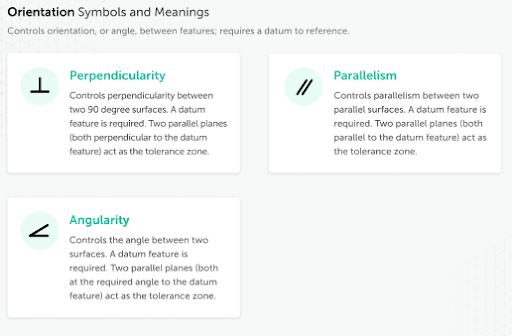
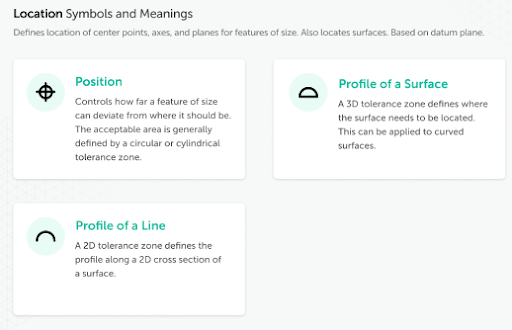
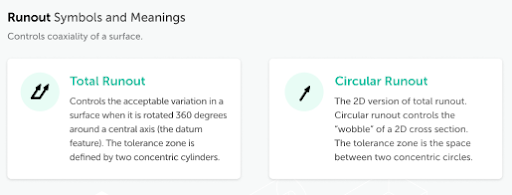
Material Condition Modifiers
In specifying geometric controls, you often need to state that a tolerance applies to a feature at a particular feature size. The terms Maximum Material Condition (MMC) and Least Material Condition (LMC) allow an engineer to communicate that intent.
These material condition modifiers are used in a feature control frame following the feature tolerance. The application of the MMC and LMC modifiers provides additional geometric tolerance beyond the specified tolerance as the features depart from the specified condition. This is often called “bonus” tolerance.
- Maximum Material Condition (MMC) – The condition where the feature contains the maximum material with the stated limits of size. (ex: largest pin and/or smallest hole)
- Least Material Condition (LMC) – The condition where the feature contains the least material within the stated limits of size. (ex: smallest pin and/or largest hole)
In the illustration below, the MMC of the hole is 19.5mm, and the LMC of the hole is 20.5mm. As another example, consider a pattern of holes dimensioned to 20+/-0.5mm with a position tolerance of 0.6mm at MMC.
In the illustration below, the MMC of the hole is 19.5mm, and the LMC of the hole is 20.5mm. The MMC for the holes is 19.5mm in diameter, and if the holes depart (get larger) from their MMC size, they are allowed additional position tolerance equal to the amount of their departure from their MMC size of 19.5mm. If the hole comes in at 20.0mm, the diameter position tolerance allowed is 1.1mm — this is how the concept of bonus tolerance works.
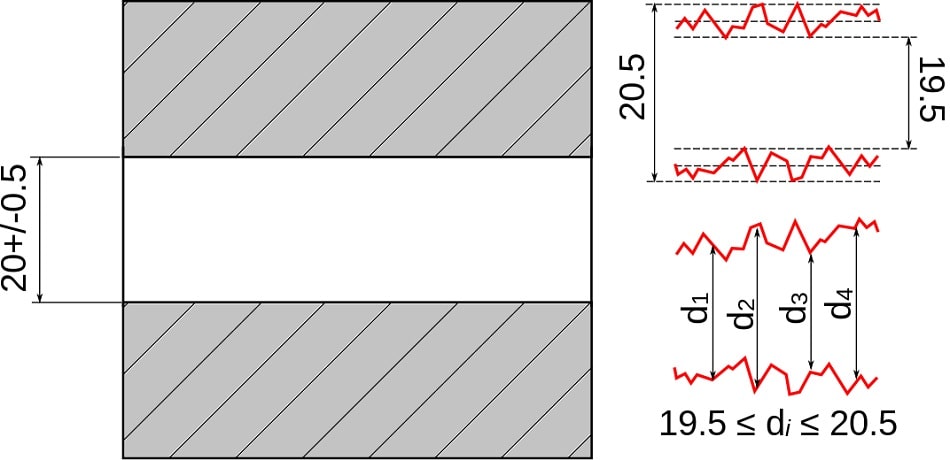
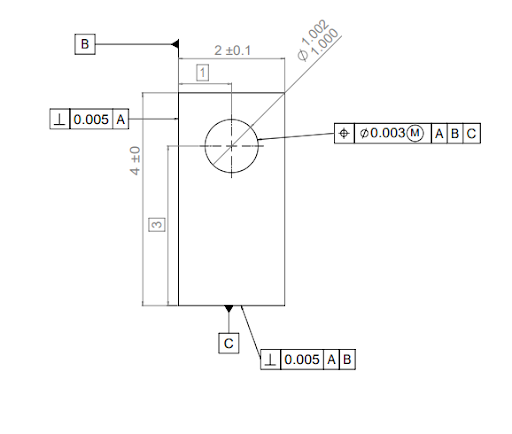
Feature Control Frames
The feature control frame states the requirements or instructions for the feature to which it is attached, so the feature control frame controls features (obvious, I know). Each feature control frame contains only one message, so if two messages for a feature are necessary, two feature control frames are required.
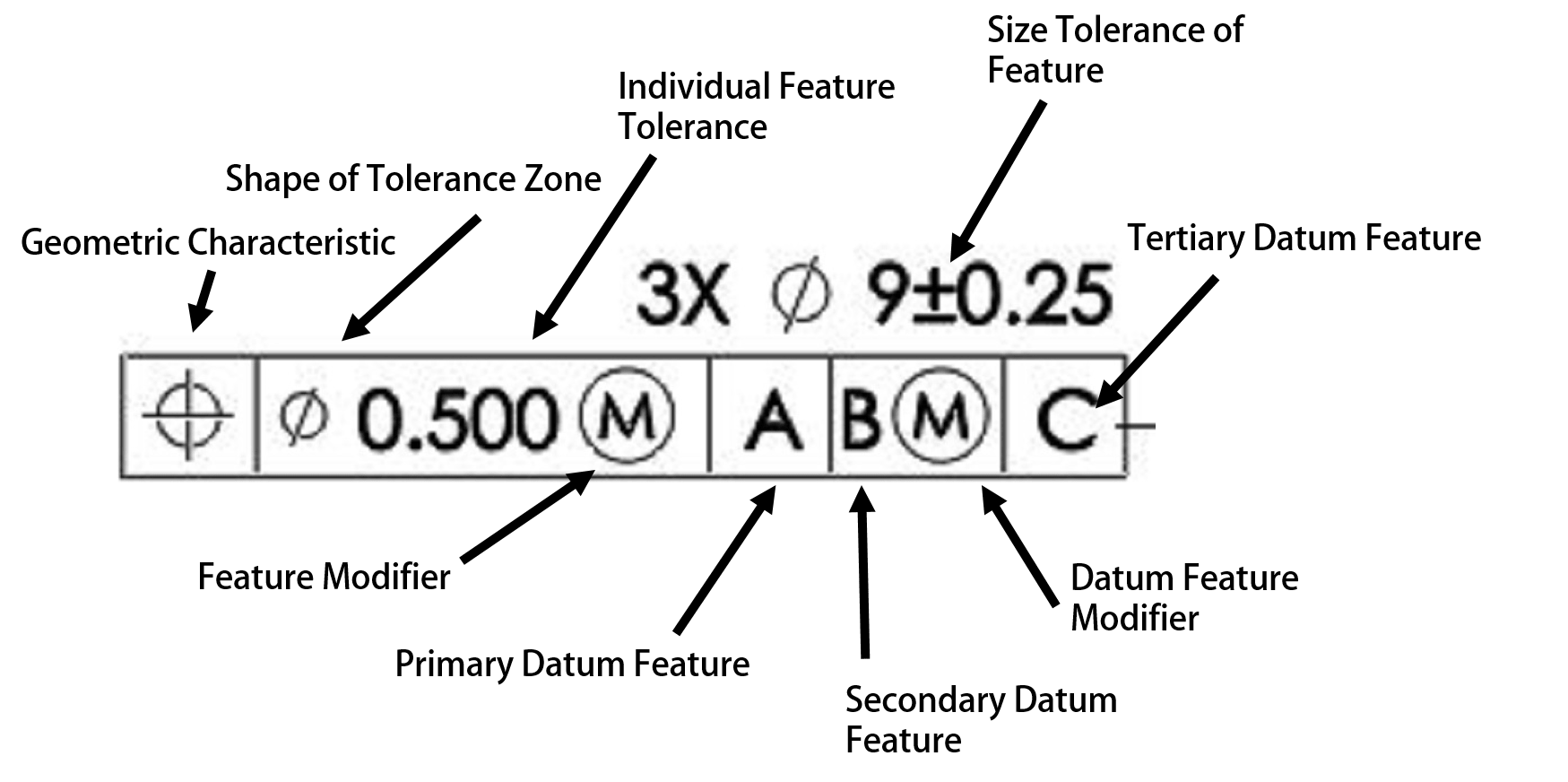
The first compartment of a feature control frame contains one of the geometric characteristic symbols. Only one of the symbols can be placed in a feature control frame. If there are two requirements for a feature, there must be two feature control frames or a composite tolerance. The symbol will specify the type of control being placed on the feature.
The second compartment of a feature control frame contains the total tolerance for the feature. The feature tolerance is always a total tolerance bound, never a plus/minus value.
If the tolerance is preceded by a diameter symbol (⌀), the tolerance zone can be pictured as a diameter or cylindrical-shaped zone — this case is often used for the position of a hole. If there is no symbol preceding the tolerance, the default tolerance zone shape is parallel planes. This case is often used to position a slot or profile of a surface.
Following the feature tolerance in the feature control frame, a material condition modifier, such as Max Material Condition (MMC) or Least Material Condition (LMC), may be specified for a feature of size, such as a hole. For a feature of size where no modifier is specified, the default modifier is RFS (Regardless of Feature Size), but this is not included in the feature control frame. For features that are not features of size, such as a plane surface, these modifiers may not be used.
All remaining compartments of the feature control frame will contain the datum feature reference(s) if they are required for the message being sent by that feature control frame. For example, if a form tolerance, such as flatness or straightness, is specified, then no datum feature reference is allowed. However, if a location tolerance like position is specified, the datum feature references are usually provided.
Technically, the alphabetical order of the datum references has no significance—the significance is their order of precedence, reading from left to right as primary, secondary, and tertiary. Often, however, Datum A will be the primary datum, followed by B and C as secondary and tertiary.
The primary is the first feature contacted (minimum contact at 3 points), the secondary feature is the second feature contacted (minimum contact at 2 points), and the tertiary is the third feature contacted (minimum contact at 1 point). Simultaneously contacting all three datum features establishes the three mutually perpendicular datum planes or the DRF. The DRF is created by Datum Simulators which are the manufacturing, processing, and inspection equipment, such as a surface plate, a collet, a three-jaw chuck, a gage pin, etc.
Now that you’ve reviewed our tips for GD&T, you’re ready to submit your well-defined drawings in tip-top shape. For more information, check out our additional resources:
Sourcing Simplified – Start Your Next Project With Fictiv
Fictiv simplifies sourcing for custom manufacturing, from 3D printed to CNC machined parts, with a focus on speed and efficiency. Our platform streamlines workflows, providing instant quotes, design for manufacturability feedback, and transparent order tracking. With Fictiv, you gain access to a Fortune 500-class supply chain and a dedicated team ensuring quality and on-time delivery.
Get started with an instant quote and experience how our technology and expertise make custom part procurement faster and easier.









